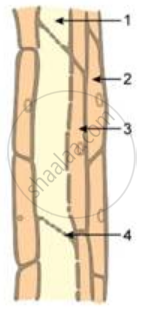Advertisements
Advertisements
प्रश्न
Explain different types of elements present in phloem.
उत्तर
Phloem consists of following four elements:
(i) Sieve tubes: These are slender, tube-like structures composed of elongated thin walls placed end to end. Their end walls, sieve plate, are perforated by large number of pores. Sieve tube elements lack nuclei, but they remain alive via adjacent companion cells.
(ii) Companion cells: They are connected with the sieve tubes via plasmodesmata. They are thin-walled cells consisting of dense and active cytoplasm and large, elongated nucleus.
(iii) Phloem parenchyma: As the name suggest, they consist of living parenchyma cells. They are involved in storage and lateral conduction of food.
(iv) Phloem fibres or bast fibres: These are dead cells of phloem possessing a narrow lumen. They are meant for providing mechanical support to the phloem.
APPEARS IN
संबंधित प्रश्न
Which tissue makes up the husk of coconut?
How are simple tissues different from complex tissues in plants?
Identify the type of tissue in the bark of tree.
Write the functions of parenchyma, collencyma and sclerenchyma.
What is the difference between parenchyma and collenchyma?
Study the diagram given below and then answer the question that follows:

Name the parts labelled 1, 2, 3 and 4.
Name the tissue associated with the following:
Conduction of water in the plant body.
Write 'True or False' for the following statement:
A vascular bundle conducts prepared food only.
Differentiate between meristematic and permanent tissues in plants
The cells or tissues of plants which have lost the power of division are called
